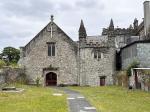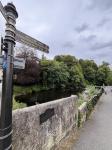Tavistock.
Situated on the western edge of Dartmoor, and just ten miles north of Plymouth, Tavistock has its own identity, partly the result of having been the seat of the most powerful abbey in the West Country during the Middle Ages. After the abbeys disillusionment by Henry V111, the town continued to prosper as a tin and wool centre, but it owes its distinctive Victorion appearance to the building boom that followed the discovery of copper deposits in the area during 1844. The cobbled stones and battlements on the Guildhall and Town Hall on Bedford Square in the centre of the town are reckoned to be some of the finest examples of Victorian architecture.
Situated behind the Town Hall, and just off the busy high street, lies the Pannier Market. Inside the Market building you can discover a wide range of traders, artists and crafts people offering a personal service with quality goods at competitive prices. The Market opens every day from Tuesday until Saturday and prides itself on the eclectic range it has to offer. During the Summer Holiday period the Market is open on Mondays too. Photographers, potters, artists, upholsterers, quilters, card makers, wood turners, and metal workers mingle with clothiers, milliners, antiques experts and furniture-makers.
Duke's Café, situated along the side of the market is well worth a visit too, it sells a wide selection of food and tasty delights to the visiting customers.
At the heart of Tavistock, opposite the Guildhall and Townhall lies St Eustachius the parish church of the town and is situated north of the old abbey. Its history dates back to the fourteenth century. Just a few remnants of the old abbey can be found in the churchyard.
The Tavistock Museum situated in the side of the Town Hall, is a fascinating town and community museum located at the historic Court Gate. We discovered a wealth of information about the local and surrounding area, including the Tavistock medieval abbey also known as the Abbey of Saint Mary and Saint Rumon, which today is a ruined Benedictine abbey. Nothing remains of the abbey except the refectory, two gateways and a porch. There was an excellent display about Sir Francis Drake, who was born in Tavistock around 1540 and his seafaring expeditions during the reign of Elizabeth 1st, as well as lots of information about the Copper and Arsenic mining along the Tamar valley during the 18th and 19th centuries. A very informative section on the 80th Anniversary of the D Day Landings and finally a fascinating and informative display of schoolbooks depicting what life was like as a child in the local village schools during the early 1900’s.
The River Tavy originates high on Dartmoor near Devil’s Tor, It winds its way down through Tavistock, where it joins the River Tamar and forms the Bere peninsula in Plymouth on the south coast.
|


